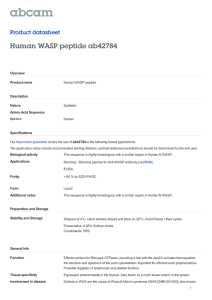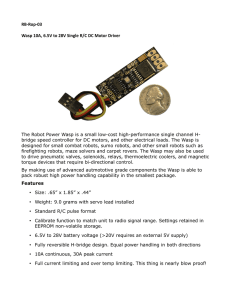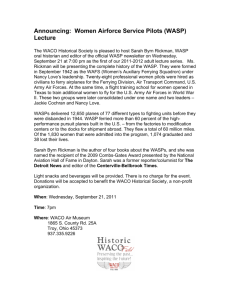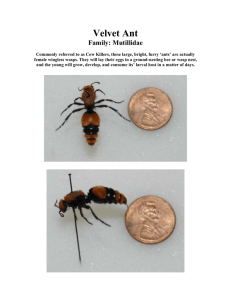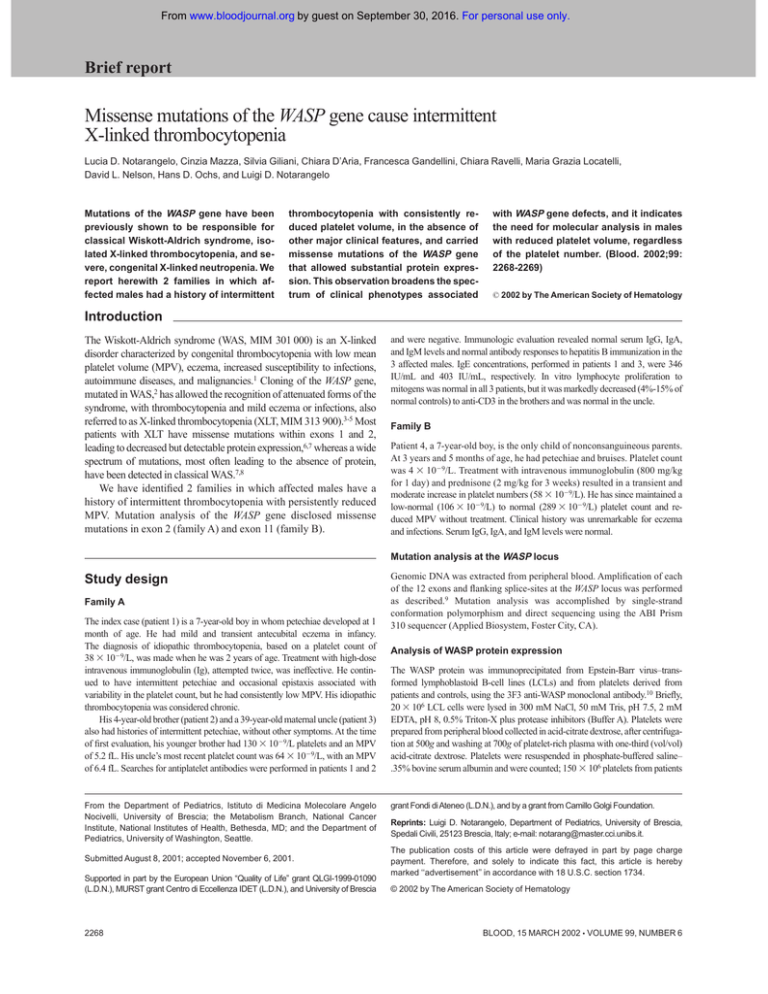
From www.bloodjournal.org by guest on September 30, 2016. For personal use only.
Brief report
Missense mutations of the WASP gene cause intermittent
X-linked thrombocytopenia
Lucia D. Notarangelo, Cinzia Mazza, Silvia Giliani, Chiara D’Aria, Francesca Gandellini, Chiara Ravelli, Maria Grazia Locatelli,
David L. Nelson, Hans D. Ochs, and Luigi D. Notarangelo
Mutations of the WASP gene have been
previously shown to be responsible for
classical Wiskott-Aldrich syndrome, isolated X-linked thrombocytopenia, and severe, congenital X-linked neutropenia. We
report herewith 2 families in which affected males had a history of intermittent
thrombocytopenia with consistently reduced platelet volume, in the absence of
other major clinical features, and carried
missense mutations of the WASP gene
that allowed substantial protein expression. This observation broadens the spectrum of clinical phenotypes associated
with WASP gene defects, and it indicates
the need for molecular analysis in males
with reduced platelet volume, regardless
of the platelet number. (Blood. 2002;99:
2268-2269)
© 2002 by The American Society of Hematology
Introduction
The Wiskott-Aldrich syndrome (WAS, MIM 301 000) is an X-linked
disorder characterized by congenital thrombocytopenia with low mean
platelet volume (MPV), eczema, increased susceptibility to infections,
autoimmune diseases, and malignancies.1 Cloning of the WASP gene,
mutated in WAS,2 has allowed the recognition of attenuated forms of the
syndrome, with thrombocytopenia and mild eczema or infections, also
referred to as X-linked thrombocytopenia (XLT, MIM 313 900).3-5 Most
patients with XLT have missense mutations within exons 1 and 2,
leading to decreased but detectable protein expression,6,7 whereas a wide
spectrum of mutations, most often leading to the absence of protein,
have been detected in classical WAS.7,8
We have identified 2 families in which affected males have a
history of intermittent thrombocytopenia with persistently reduced
MPV. Mutation analysis of the WASP gene disclosed missense
mutations in exon 2 (family A) and exon 11 (family B).
and were negative. Immunologic evaluation revealed normal serum IgG, IgA,
and IgM levels and normal antibody responses to hepatitis B immunization in the
3 affected males. IgE concentrations, performed in patients 1 and 3, were 346
IU/mL and 403 IU/mL, respectively. In vitro lymphocyte proliferation to
mitogens was normal in all 3 patients, but it was markedly decreased (4%-15% of
normal controls) to anti-CD3 in the brothers and was normal in the uncle.
Family B
Patient 4, a 7-year-old boy, is the only child of nonconsanguineous parents.
At 3 years and 5 months of age, he had petechiae and bruises. Platelet count
was 4 ⫻ 10⫺9/L. Treatment with intravenous immunoglobulin (800 mg/kg
for 1 day) and prednisone (2 mg/kg for 3 weeks) resulted in a transient and
moderate increase in platelet numbers (58 ⫻ 10⫺9/L). He has since maintained a
low-normal (106 ⫻ 10⫺9/L) to normal (289 ⫻ 10⫺9/L) platelet count and reduced MPV without treatment. Clinical history was unremarkable for eczema
and infections. Serum IgG, IgA, and IgM levels were normal.
Mutation analysis at the WASP locus
Study design
Family A
The index case (patient 1) is a 7-year-old boy in whom petechiae developed at 1
month of age. He had mild and transient antecubital eczema in infancy.
The diagnosis of idiopathic thrombocytopenia, based on a platelet count of
38 ⫻ 10⫺9/L, was made when he was 2 years of age. Treatment with high-dose
intravenous immunoglobulin (Ig), attempted twice, was ineffective. He continued to have intermittent petechiae and occasional epistaxis associated with
variability in the platelet count, but he had consistently low MPV. His idiopathic
thrombocytopenia was considered chronic.
His 4-year-old brother (patient 2) and a 39-year-old maternal uncle (patient 3)
also had histories of intermittent petechiae, without other symptoms. At the time
of first evaluation, his younger brother had 130 ⫻ 10⫺9/L platelets and an MPV
of 5.2 fL. His uncle’s most recent platelet count was 64 ⫻ 10⫺9/L, with an MPV
of 6.4 fL. Searches for antiplatelet antibodies were performed in patients 1 and 2
From the Department of Pediatrics, Istituto di Medicina Molecolare Angelo
Nocivelli, University of Brescia; the Metabolism Branch, National Cancer
Institute, National Institutes of Health, Bethesda, MD; and the Department of
Pediatrics, University of Washington, Seattle.
Submitted August 8, 2001; accepted November 6, 2001.
Supported in part by the European Union “Quality of Life” grant QLGI-1999-01090
(L.D.N.), MURST grant Centro di Eccellenza IDET (L.D.N.), and University of Brescia
2268
Genomic DNA was extracted from peripheral blood. Amplification of each
of the 12 exons and flanking splice-sites at the WASP locus was performed
as described.9 Mutation analysis was accomplished by single-strand
conformation polymorphism and direct sequencing using the ABI Prism
310 sequencer (Applied Biosystem, Foster City, CA).
Analysis of WASP protein expression
The WASP protein was immunoprecipitated from Epstein-Barr virus–transformed lymphoblastoid B-cell lines (LCLs) and from platelets derived from
patients and controls, using the 3F3 anti-WASP monoclonal antibody.10 Briefly,
20 ⫻ 106 LCL cells were lysed in 300 mM NaCl, 50 mM Tris, pH 7.5, 2 mM
EDTA, pH 8, 0.5% Triton-X plus protease inhibitors (Buffer A). Platelets were
prepared from peripheral blood collected in acid-citrate dextrose, after centrifugation at 500g and washing at 700g of platelet-rich plasma with one-third (vol/vol)
acid-citrate dextrose. Platelets were resuspended in phosphate-buffered saline–
.35% bovine serum albumin and were counted; 150 ⫻ 106 platelets from patients
grant Fondi di Ateneo (L.D.N.), and by a grant from Camillo Golgi Foundation.
Reprints: Luigi D. Notarangelo, Department of Pediatrics, University of Brescia,
Spedali Civili, 25123 Brescia, Italy; e-mail: notarang@master.cci.unibs.it.
The publication costs of this article were defrayed in part by page charge
payment. Therefore, and solely to indicate this fact, this article is hereby
marked ‘‘advertisement’’ in accordance with 18 U.S.C. section 1734.
© 2002 by The American Society of Hematology
BLOOD, 15 MARCH 2002 䡠 VOLUME 99, NUMBER 6
From www.bloodjournal.org by guest on September 30, 2016. For personal use only.
BLOOD, 15 MARCH 2002 䡠 VOLUME 99, NUMBER 6
WASP MUTATIONS IN INTERMITTENT THROMBOCYTOPENIA
Figure 1. Profile of platelet count in males with intermittent thrombocytopenia
and WASP gene mutations. Profile of platelet count in patient 1 (closed circle),
patient 2 (open circle), and patient 4 (open triangle) since they were first seen at the
Department of Pediatrics, University of Brescia. The shaded area represents the
normal range for platelet count. Only recent data were available for patient 3 (not
shown), who had thrombocytopenia and a small mean platelet volume.
and controls were lysed with Buffer A. For LCL and for platelets, lysates were
normalized for protein amount using the Bio-Rad Protein Assay (Bio-Rad
Laboratories, Hercules, CA). Equal amounts of protein were incubated with
protein G–Sepharose coupled with 3F3 monoclonal antibody and were run on
8% sodium dodecyl sulfate–polyacrylamide gel electrophoresis at 80 V for 16
hours. The gel was transferred to a polyvinylidene difluoride membrane
(Immobilon-P; Millipore, Bedford, MA) and was blotted with rabbit polyclonal
antibody against WASP (H250-SC8353; Santa Cruz Biotechnology, Santa Cruz,
CA) using a secondary anti-rabbit IgG POD (Hoffmann-LaRoche, Basel,
Switzerland), and then it was revealed with enhanced chemiluminescence
(Amersham Pharmacia Biotech, Little Chalfont, United Kingdom).
Results and discussion
As depicted in Figure 1, patients 1, 2, and 4 showed variability of platelet
numbers, ranging from very low to normal, whereas the MPV was
consistently reduced, regardless of the platelet count (ranges, 5-6.3 fL
for patient 1; 5.2-5.4 fL for patient 2; 4.7-6.4 fL for patient 4; normal
range, 7-10 fL). Only limited information is available for patient 3,
whose most recent platelet counts were low (37-64 ⫻ 10⫺9/L) and who
had a reduced MPV (6.2-6.4 fL). Clinically, the platelet counts
correlated with the appearance of petechiae. No major episodes of
bleeding were recorded, and no transfusions were required. Because of
the history and the reduced platelet count and volume, mutation analysis
at the WASP locus was performed.
In family A, a C207G nucleotide substitution in exon 2 was
identified in all 3 affected males, resulting in a Pro58Arg amino
acid change. Heterozygosity for this mutation was detected in the
mother of the 2 boys. In family B, a T1476A point mutation in exon
11 was detected in the affected boy, resulting in an Ile481Asn
2269
Figure 2. Analysis of WASP protein expression in 4 males with intermittent
X-linked thrombocytopenia. (top) Pedigrees of the 2 families with intermittent
X-linked thrombocytopenia. (bottom) Western-blot analysis of WASP protein expression in platelets and in Epstein-Barr virus–transformed lymphoblastoid B cell lines
(LCL) derived from the patients and from a normal control (C).
amino acid substitution. The mother was found to be a carrier for
this mutation. It is unlikely that these genetic abnormalities are
polymorphisms because the nucleotide changes were not detected
in more than 300 normal X chromosomes.
Mutations of the WASP gene have been previously shown to be
responsible for 3 different clinical phenotypes: classical WAS,
XLT, and X-linked congenital neutropenia.1,6,11 The spectrum of
phenotypes associated with abnormalities of the WASP gene
reflects heterogeneity of the mutations. In particular, XLT usually
entails missense mutations in exons 1 and 2 and decreased amounts
of mutated protein, whereas classical WAS is associated with a
variety of genetic defects that usually result in the absence or
truncation of WASP.6,8 Our 2 families had missense mutations
involving exon 2 (C207G) and 11 (T1476A), respectively. As
shown in Figure 2, these mutations allow substantial protein
expression. Reduced amounts of WASP protein were detected in
LCL and platelets from patient 2 and in platelets from patient 1,
whereas normal amounts were detected in patient 4 (for LCL and
platelets) and in patient 3 (for LCL).
The 2 families with intermittent thrombocytopenia had in common
consistently small platelet size, minimal if any bleeding, and, in most
members, no eczema or increased susceptibility to infections. Two of the
3 affected males from family A had low proliferative responses to
anti-CD3 in vitro and moderately elevated serum IgE levels. These
immunologic abnormalities are typical of WAS/XLT.12,13
The intermittent thrombocytopenia reported herewith represents the mildest consequence of WASP mutations. Because none
of the affected males had serious problems, no long-term treatment
was indicated. In view of our findings, males with persistently low
MPV must be considered for mutation analysis at the WASP locus,
regardless of the platelet count.
References
1. Ochs HD, Rosen FS. The Wiskott-Aldrich syndrome. In: Ochs HD, Smith CIE, Puck JM, eds.
Primary Immunodeficiency Diseases: A Molecular
and Genetic Approach. New York, NY: Oxford
University Press; 1999:292-305.
2. Derry JMJ, Ochs HD, Francke U. Isolation of a
novel gene mutated in Wiskott-Aldrich syndrome.
Cell. 1994;78:635-644.
3. Villa A, Notarangelo LD, Macchi P, et al. X-linked
thrombocytopenia and Wiskott-Aldrich syndrome
are allelic diseases with mutations in the WASP
gene. Nat Genet. 1994;9:414-417.
4. Derry JMJ, Kerns JA, Weinberg KI, et al. WASP
gene mutations in Wiskott-Aldrich syndrome and
X-linked thrombocytopenia. Hum Mol Genet.
1995;4:1127-1135.
5. Kolluri R, Shehabeldin A, Peacocke M, et al.
Identification of WASP mutations in patients with
Wiskott-Aldrich syndrome and isolated thrombocytopenia reveals allelic heterogeneity at the
WAS locus. Hum Mol Genet. 1995;4:1119-1126.
6. Zhu Q, Watanabe C, Liu T, et al. Wiskott-Aldrich
syndrome/X-linked thrombocytopenia: WASP
gene mutations, protein expression, and phenotype. Blood. 1997;90:2680-2689.
7. Shcherbina A, Rosen FS, Remold-O’Donnell E.
WASP levels in platelets and lymphocytes of Wiskott-Aldrich syndrome patients correlate with cell
dysfunction. J Immunol. 1999;163:6314-6320.
8. Schwarz K. WASPbase: a database of WAS- and
XLT-causing mutations. Immunol Today. 1996;17:
496-502.
9. Giliani S, Fiorini M, Mella P, et al. Prenatal molecular
diagnosis of Wiskott-Aldrich syndrome by direct mutation analysis. Prenat Diagn. 1999;19:36-40.
10. Stewart DM, Treiber-Held S, Kurman CC, Facchetti F, Notarangelo LD, Nelson DL. Studies of
the expression of the Wiskott-Aldrich syndrome
protein. J Clin Invest. 1996;97:2627-2634.
11. Devriendt K, Kim AS, Mathijs G, et al. Constitutively activating mutation in WASP causes
X-linked severe congenital neutropenia. Nat
Genet. 2001;27:313-317.
12. Molina IJ, Sancho J, Terhorst C, Rosen FS, Remold-O’Donnell E. T cells of patients with the
Wiskott-Aldrich syndrome have a restricted defect in proliferative responses. J Immunol. 1993;
151:4383-4390.
13. Zhang J, Shehabeldin A, da Cruz LAG, et al. Antigen receptor-induced activation and cytoskeletal
rearrangement are impaired in Wiskott-Aldrich
syndrome protein-deficient lymphocytes. J Exp
Med. 1999;190:1329-1341.
From www.bloodjournal.org by guest on September 30, 2016. For personal use only.
2002 99: 2268-2269
doi:10.1182/blood.V99.6.2268
Missense mutations of the WASP gene cause intermittent X-linked
thrombocytopenia
Lucia D. Notarangelo, Cinzia Mazza, Silvia Giliani, Chiara D'Aria, Francesca Gandellini, Chiara Ravelli, Maria
Grazia Locatelli, David L. Nelson, Hans D. Ochs and Luigi D. Notarangelo
Updated information and services can be found at:
http://www.bloodjournal.org/content/99/6/2268.full.html
Articles on similar topics can be found in the following Blood collections
Brief Reports (1900 articles)
Clinical Trials and Observations (4395 articles)
Information about reproducing this article in parts or in its entirety may be found online at:
http://www.bloodjournal.org/site/misc/rights.xhtml#repub_requests
Information about ordering reprints may be found online at:
http://www.bloodjournal.org/site/misc/rights.xhtml#reprints
Information about subscriptions and ASH membership may be found online at:
http://www.bloodjournal.org/site/subscriptions/index.xhtml
Blood (print ISSN 0006-4971, online ISSN 1528-0020), is published weekly by the American Society of
Hematology, 2021 L St, NW, Suite 900, Washington DC 20036.
Copyright 2011 by The American Society of Hematology; all rights reserved.


